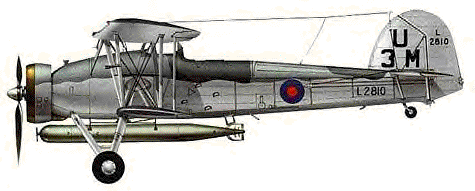Classic Combat Aircraft | home
Fairey Swordfish

By far the most successful and famous biplane fighting aircraft of W.W.II. Its naval nickname was "Stringbag".
Little different from the biplanes of World War I and totally obsolete by World War II, the Fairey Swordfish remarkably remained operational until after 1945. Slow and almost defenseless, it was a successful torpedo bomber against light opposition. Swordfish crippled the Italian fleet at Tarente and helped to sink the German Bismarck. Its main advantage was strength, ease of maintenance, and great flying qualities. Swordfish could be flown from aircraft carriers, even in rough seas. By the end of 1941, the wartime Swordfish was confined mainly to antisubmarine operations.
In Canada, Swordfish operated from the Naval Gunnery School in Yarmouth and the Royal Navy Station at Dartmouth, Nova Scotia. In 1946, Fleet Requirement Unit 743 (RCN) was equipped with Swordfish

Type: Torpedo bomber
Power plant One Bristol Pegasus 30; 9 cylinder radial engine
Wingspan 45.50 ft 13.87 m
Length 35.66 ft 10.87 m
Height 12.3 ft 3.75 m
Weight max. 8,896 LB 4,035 kg
Speed 143 mph 230 km/h
Ceiling 12,400 ft 3,780 m
Range 770 mi 1,240 km
Armament 2x 7.7mm machine gun; 1x 730 kg torpedo or 1x 680 kg mine (ev. deep bombs)
Crew 2 - 3
